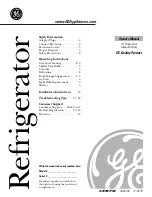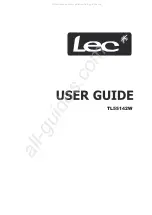
Operating Instructions
TEMPERATURE
SELECTION
To avoid vibration, the unit must be on a level surface. This is
accomplished by adjusting the leveling legs located under the refrigerator.
The temperature of the refrigerator is controlled by setting the thermostat
knob to a desired setting.
BEFORE USING
1.
Before the refrigerator is plugged in check and make sure the electric
voltage to be used is the same as the rated voltage. The power plug
should have its own independent socket. Using an adapter may cause
the socket to overheat.
2. Do not
store flammable materials such as ether, benzine, LP gas and
glue etc in the refrigerator.
3. Do not
splash water on the refrigerator, it may cause a malfunction or
electric shock.
4.
When operating the refrigerator for the first time, run it without loading
any food until it auto stops at the desired temperature, usually it takes
2 or 3 hours. Then set the thermostatic dial at the setting desired and
put food in the refrigerator.
1.
The temperature of the refrigerator can be adjusted by turning the
thermostatic dial. A medium setting of the thermostatic dial is the most
suitable for general operation.
(Fig.B)
2.
Defrost the freezer compartment whenever the layer of frost on the
surface of the evaporator reaches 3 or 4 mm. When defrosting remove
all food and set the thermostat to the “OFF” position. Put the drip tray
under the evaporator to collect melted water. After the frost has melted,
discard the melted water and dry the interior of refrigerator. The
refrigerator can then be restarted by turning its thermostat to the desired
setting.
3. Instruction for making and removing ice cubes.
Fill the ice cube tray with water below the graduated line, put it into
the freezer compartment and then set the thermostat at “6” position. It
takes about 2 or 3 hours to make ice cubes. Pieces of ice cube can be
removed by twisting the ice making tray.
Fig.A - MAX
Fig.B - MED
Fresh Food Compartment
•
Never cover food compartment shelves with aluminum foil or any other
shelf covering material which may prevent air circulation.
•
Always remove porous store wrapping paper from meats, poultry and
fish. Meats should be wrapped individually and placed in a dish for
storage. Wrap fish and poultry in foil or heavy waxed paper. Most fish
should be used the same day of purchase. Packaged meats such as
ham, bacon, dried beef, or frankfurter, store best in their original pack-
ages.
•
Allow warm foods to cool to room temperature before placing them in
the refrigerator.
•
Always cover open dishes of food, especially leftovers. Use leftovers
within 2 or 3 days.
FOOD STORAGE
SUGGESTIONS
5



































